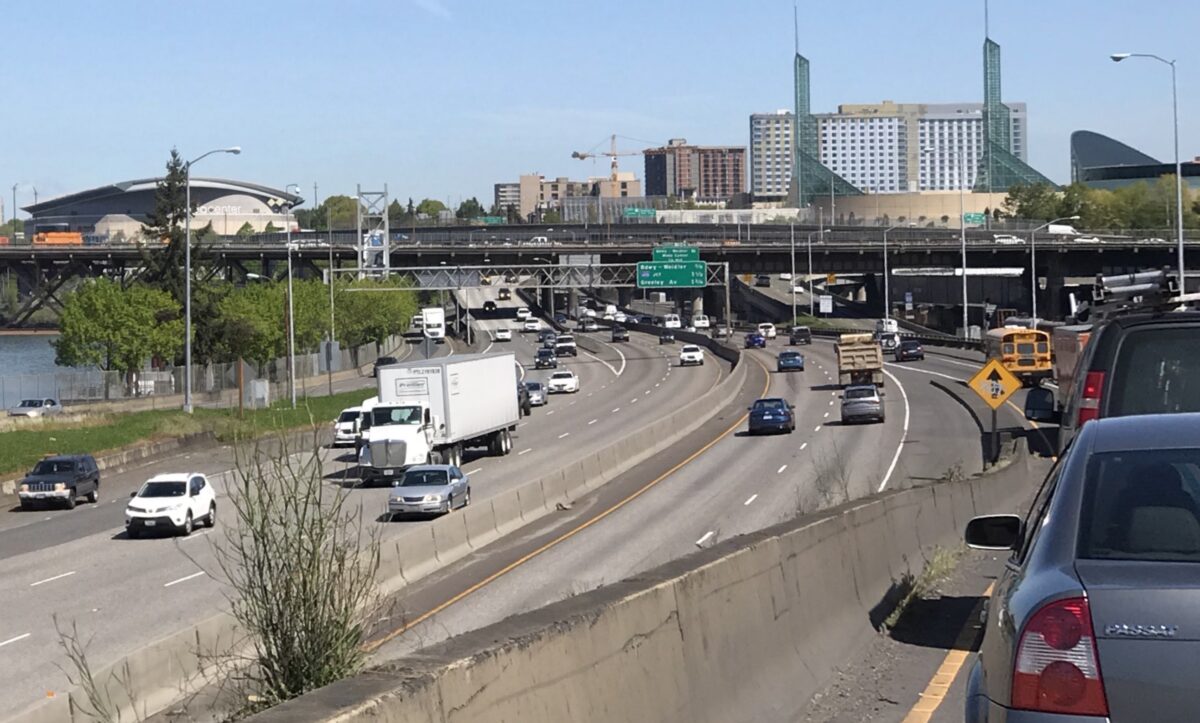
Now that the City of Portland and the Albina Vision Trust have both signed onto Oregon Department of Transportation plans to expand I-5 at the Rose Quarter it may seem like smooth sailing for the controversial project. And if Governor Kate Brown gets her wish, pro-freeway candidate Lee Beyer will be the next member of the Oregon Transportation Commission (OTC), which would give the project even more institutional support within the state legislature.
But it’s not exactly a well-paved road ahead. People who oppose the project aren’t going to back down, and there are some thorny issues left to navigate. Here’s a rundown of recent developments:
The Tubman Middle School dilemma
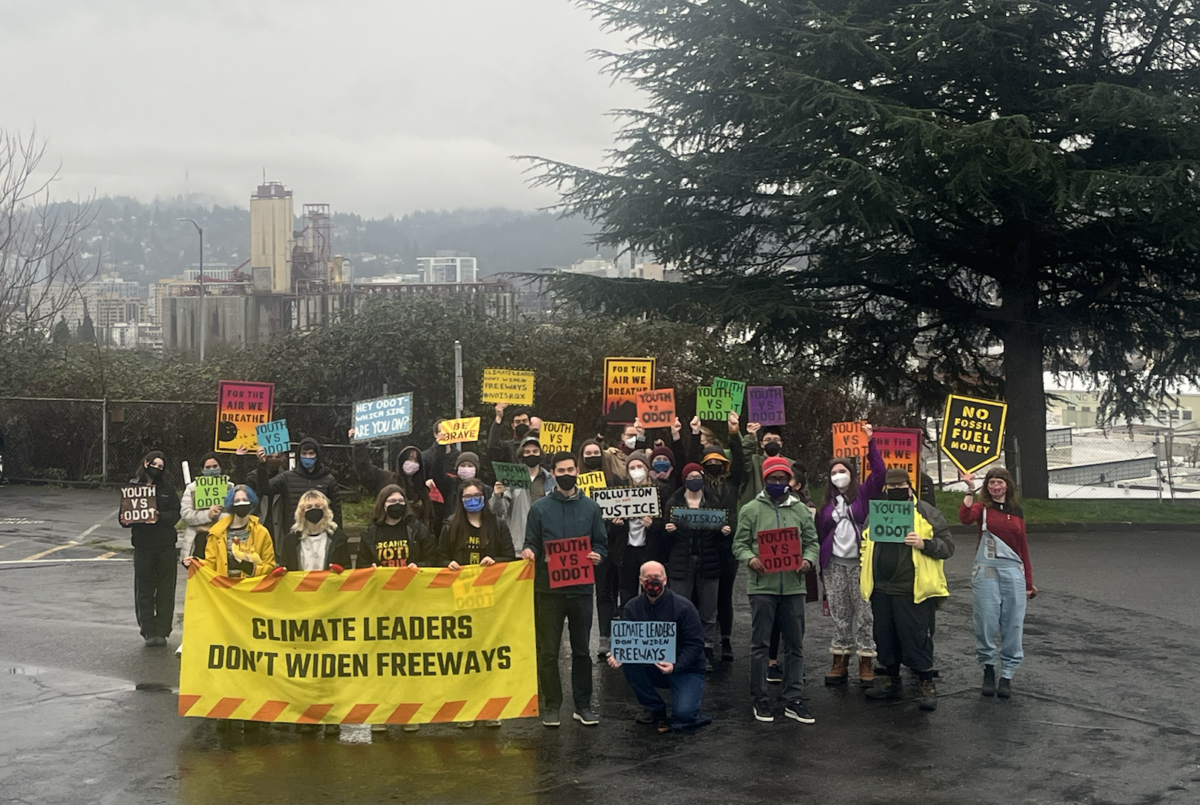
Last week, the Oregonian reported Portland Public Schools (PPS) has narrowed down its choices for where to relocate Harriet Tubman Middle School. The school currently sits adjacent to I-5 and ODOT’s project will bring lanes even closer to students’ lungs. Tubman Middle School (and its students and staff) has been a pawn in the freeway expansion plan and previous proposals for relocation have drawn a lot of ire.
PPS promised to keep the middle school within the current community boundaries, but it’s been difficult for them to find a suitable site. The two locations the district has its eye on now are: the Jefferson High School campus on NE Killingsworth Street and the current PPS headquarters located right across I-5 from Tubman’s current location.
According to The Oregonian, both of these potential sites have downsides. Adding a middle school to the Jefferson High School campus could result in problems for both middle and high schoolers, who would have to share a limited amount of athletic space. The Jefferson High School campus, located in the Humboldt neighborhood in north Portland, is also a mile and a half walk from Tubman’s current site. The PPS headquarters are much closer, but the location is surrounded by busy roads with equally toxic emissions with few pedestrian accommodations – plus this move would mean the PPS main offices would have to be relocated as well. Either way, the move may trigger another set of difficult and potentially unpopular decisions that ODOT will have to answer for.
Environmental review pressure
Meanwhile, anti-freeway activists continue to push ODOT to complete an Environmental Assessment for the project, which ODOT has attempted to avoid in the past. No More Freeways (NMF) is pushing the transportation department to complete a thorough Environmental Impact Statement (EIS) which includes a 90-day public comment period and public hearing as well as specific information omitted in previous environmental reviews. Last week, NMF and the Eliot Neighborhood Association sent ODOT a letter (PDF) asking them to share an update on their plans for the EIS.
“We are proactively reaching out to you now to ask for this full 90-day public comment period because the 45-day public comment period the agency provided in 2019 during the original Environmental Assessment (EA) was wholly inadequate. We wish to make explicit our desire that the full community, and not just ODOT’s hand-picked boosters, are given a fair and equal opportunity to weigh in about their concerns,” NMF wrote to ODOT.
The group posed several questions to ODOT about the EIS, including:
● Will ODOT commit to releasing all of the traffic modeling data used to produce traffic projections? If so, will ODOT commit to making the data promptly available in an electronic format?
● Will ODOT release detailed plans showing the actual dimensions of the proposed roadway and structures?
● Will ODOT provide a complete and detailed financial plan for the project showing the sources and uses of all funds, including potential toll revenues?
● Will ODOT’s traffic modeling include the impact of the Regional Mobility Pricing Program?
● Will ODOT’s traffic modeling rely on any assumptions, such as the existence of other yet to be constructed or approved projects (including but not limited to the Interstate Bridge)?
As far as we know, ODOT hasn’t yet responded to this email. According to the Rose Quarter project website, the supplemental environmental review process is nearing completion, but the department hasn’t provided an update on their progress since the federal government ordered them to complete a review last year.
ODOT: Everything’s fine!
ODOT is continuing their public relations campaign to rally support for the project. Representatives for the department tabled at the recent TriMet event celebrating the opening of the Division Street FX bus line and even handed out Rose Quarter expansion project-themed children’s activity books and crayons. (This was not received well by anti-freeway activists.)
Yesterday afternoon, ODOT’s Urban Mobility office sent a press release sharing results from a public opinion survey conducted over the summer (PDF), saying that more than 75% of 624 respondents across Multnomah, Washington and Clackamas counties support the project, with 30% “strongly” supporting the project. According to ODOT, survey respondents believe it’s a good idea to include shoulders and auxiliary lanes as a way to relieve traffic congestion.
ODOT shared supporter and opponent talking points with survey respondents, citing opponents as believing the project will “increase demand and bring more cars to the area increasing greenhouse gas emissions and worsening air quality in the area…freeways are also massively expensive, and rob our city, region and state of the funding necessary to build better bus lanes, fix up potholed roads, and invest in more dangerous sections of highways that frequently harm and kill Oregonians biking, walking and driving.”
This argument was evidently impactful, as support for the project dipped by seven points after respondents heard it.
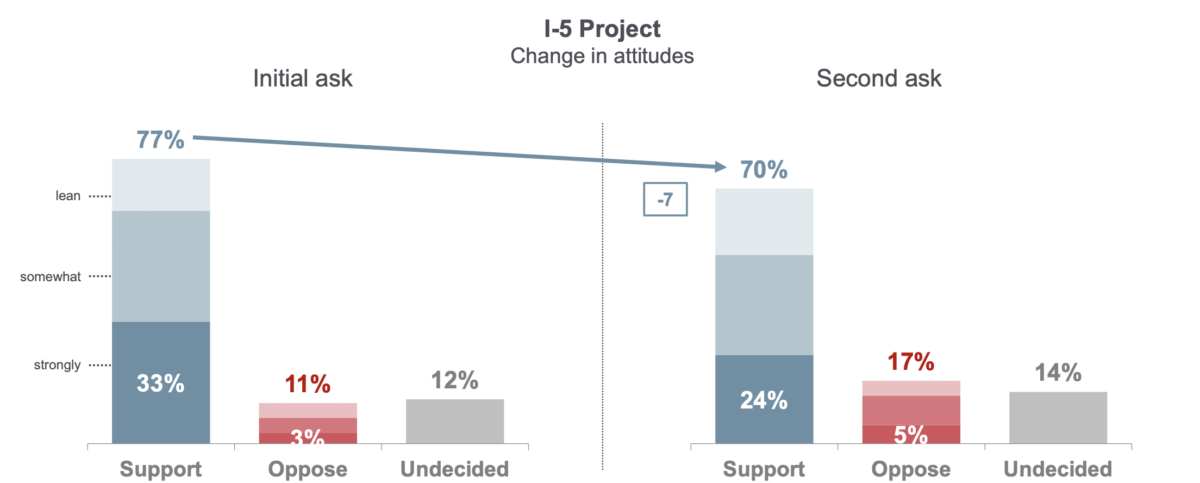
ODOT explained this lost support by saying the people who changed their mind after hearing the opposing perspective were “persuadable targets” and are unfamiliar with the area and travel through it less often. After Rose Quarter project leaders told them about “specific components and goals” from ODOT’s point of view, support rebounded. Survey respondents indicated strong support for ODOT’s stated project goals to increase mobility and reduce greenhouse gas emissions through expanding the highway, and they also showed support for ODOT’s explanation of auxiliary lanes.
But freeway expansion opponents say ODOT lied about the projects to survey respondents, made unsubstantiated claims (like how lane expansions solve traffic congestion), and defined their plans for the project in a misleading way.
Critics want to make sure the community is aware of all the facts – as well as other ways to mitigate congestion – before ODOT moves forward.
ODOT will present their survey results to the Historic Albina Advisory Board Tuesday afternoon, and you can watch that meeting here. Stay tuned for more as the political situation surrounding this project continues to unfold.


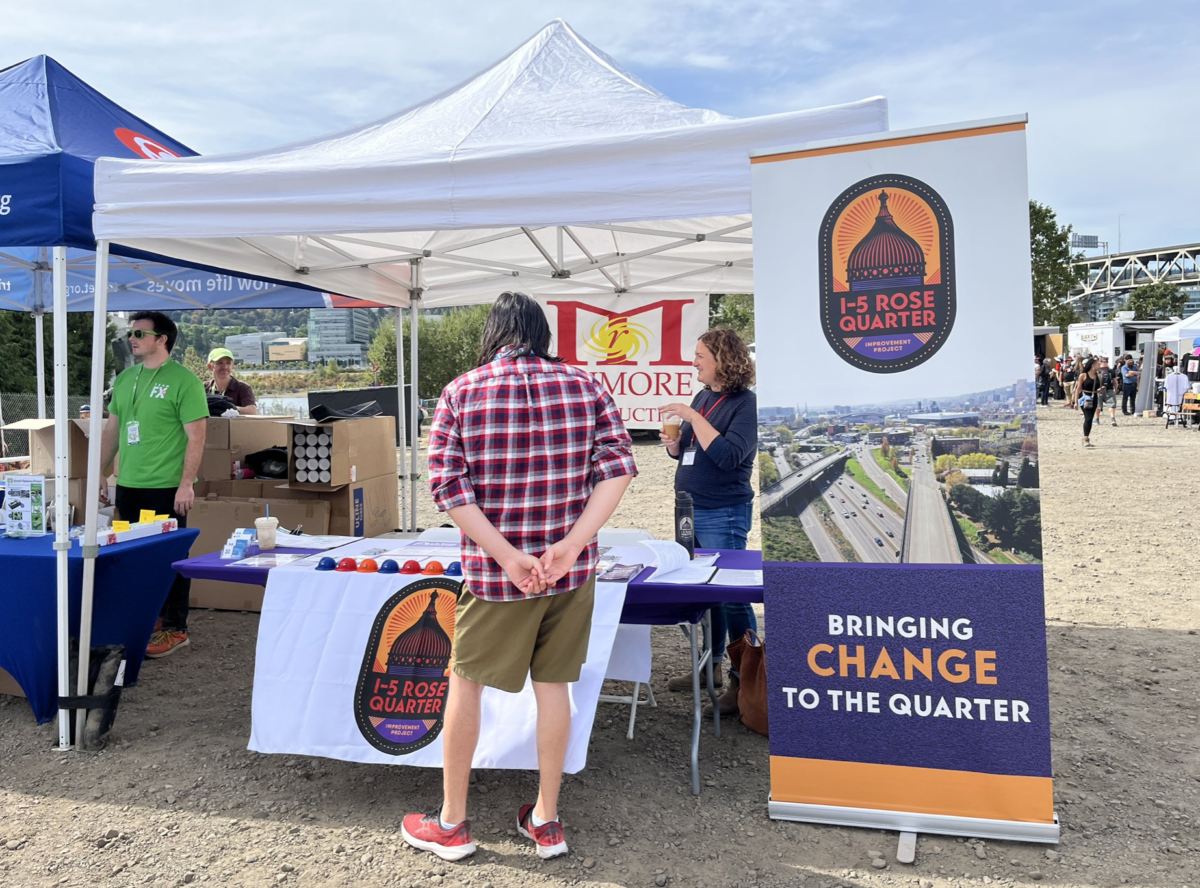

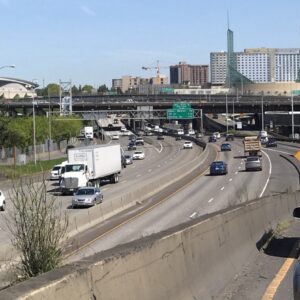

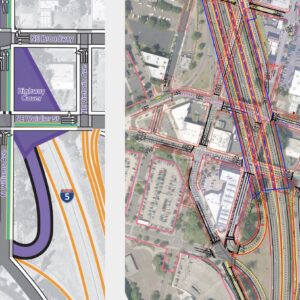
Thanks for reading.
BikePortland has served this community with independent community journalism since 2005. We rely on subscriptions from readers like you to survive. Your financial support is vital in keeping this valuable resource alive and well.
Please subscribe today to strengthen and expand our work.
Of course people vote yes for this. Take any complex issue that people don’t fully understand and make promises about how doing a thing related to the issue will make their lives better, why would anyone say no?
Also why is there such a big focus on Clackamas county residents in the survey?
Because Clackamas County residents love their car and don’t plan on going anywhere in Albina anyways xD
I’d be curious to hear those same people’s opinions on the Abernathy project and the tolling that’s about to start down there…
Coming from a recent Wilsonville transplant. Like a lot of things, there is a vocal minority of people who think tolling on the 205 or anywhere is abhorrent, but most people are fine with it. A lot of folks have said, “if that’s the cost of not living in Portland, so be it” and I agree. I used to give Portland and Multnomah county a portion of my salary to not do the things they say they are going to do. If paying a toll gets me to the airport faster during rush hour and I get to skip the Portland junk, it is hard to get upset about it.
It’s Abernethy, with one A and two Es.
Yeah the first thing I noticed in their press release was that it sure seemed like many of the survey respondents did not live someplace where the existence of the freeway expansion would impact them unless they were daggone driving on it.
When you have to move an entire school because the project is going to release more harmful pollution, shouldn’t that be the point we step back and ask wtf are we doing?
The school should never been located next to the freeway. Regardless of what happens to this project, the school should relocate.
Actually, the school was built in 1952, about 10 years before the freeway was built. That strengthens your point (that I agree with) that schools generally shouldn’t be next to freeways. In this case, the original error wasn’t putting the school next to a freeway, it was building a freeway next to the school, without requiring the freeway to mitigate the impacts (by moving the school, burying the freeway, etc.).
So many expensive projects being done today (sound walls, lids, pedestrian/bike bridges…) are things that should have been built into the original freeway/highway budgets.
Eliot Elementary School, which became Harriet Tubman Middle School, was an elementary school serving majority-Black Albina before I5 was built. The school was there first.
The school was built about 10 years before the freeway. So the freeway should have never been built next to the school in the first place…
The school was closed. It was then reopened at the insistence of the black community.
Can’t blame ODOT for that decision.
“For advocates of reopening the school, a move championed by leaders of the black community, including state Sen. Lew Frederick (D-Portland), in whose district the school sits, the new information is disturbing.”
https://www.wweek.com/news/2018/07/04/a-middle-school-prized-by-portlands-black-community-would-see-its-poor-air-quality-worsen-with-a-rose-quarter-highway-expansion/
So PPS should have just accepted a complete loss at that location once the freeway was built? Tear down the building and go home? We don’t have public school funding levels to just build new schools when we feel like it.
It was closed after 2012. The kids were going to other schools before Tubman was reopened in 2018.
Sounds like PPS accepted a risk to have the additional capacity and people want to blame ODOT for it.
And people DO love to vote for school bond measures, so I’d say the money would likely have been available.
Yes, but ODOT is responsible for the devaluation of this property as a possible school location. The Portland taxpayers should not have to pay for ODOT’s negative externalities.
Which taxpayers should pay for those externalities?
The ones that use I-5 (all Oregonians).
We literally do have the money to build new schools when we feel like it. PPS raises funds through bonds like property taxes are inconsequential. Further, they routinely obfuscate the actual costs to keep the bond issuance amounts popular, knowing that the residents will keep taking it on the chin for their mismanagement. All to have terrible academic outcomes as a result. Its a great system.
PS,
You just noted above that you live in Wilsonville and avoid Portland like the plague. Who are “we” in your comment?
Haha, yes, my bad. My colloquial use of “we” in lieu of “you” and my mentioned Wilsonville residency must mean my opinion on the matter is null and void. Good work, the gods of pedantic internet commentary are bestowing their best graces in your direction.
The school reopened at the insistence of many people of all races in Irvington, Sabin, King, Boise, and Eliot. This was one of the few neighborhoods without a middle school, and the middle schools in a few of the K-8 schools were tiny. We needed a comprehensive middle school to provide a quality education for kids in this neighborhood. Many parents several years trying to find a solution, and shifting the four K-8s (Irvington, Sabin, King, and Boise-Eliot/Humboldt) back to K-5s and opening a middle school made sense for a host of reasons, and there was simply no other location that could work.
Which is what is so incredibly frustrating about the process that PPS just went through: we just did it a few years ago when Tubman reopened. One of my friends (a white mom, for whatever that is worth) made an extensive spreadsheet listing every PPS property and other potential sites in these neighborhoods and a few miles outside of this neighborhood. We discussed these options endlessly in the parent groups, PTAs, and with PPS. Tubman was the only and therefore best option. The problems with the Tubman location existed then, but there was no where else.
The alternative would have been to keep kids in middle schools with total enrollments of 50-60 kids across three grades.
Yes, Tubman is prized by the Black community, as it should be. It originally opened as a middle school a few decades ago and was a real gem. And then it reopened because we needed a middle school. And yes, many Black community members were at the forefront, but with many other parents cheering right beside them.
PPS reopended the school already knowing the risks.
That’s on PPS, not ODOT.
If I bought a house near PIR and complain about noise/pollution, is that PIR’s fault?
If you bought a house near the Vanport flood plain back in 1955 and then PIR was built (1960), then you moved away for a while, then moved back in. Now PIR is widening their track, which moves the noise and pollution closer to your backyard. You owned the house the entire time, but now you don’t want to live there.
I think you would be justified in complaining about PIR, as it wasn’t there when you originally bought the house, and their expansion is decreasing your quality of life and health.
I think you’d be justified in complaining, but a lot of people would say “you should have known the risks.”
It’s the same argument people have about those living near a commercial zone complaining when a bar opens up and changes the situation, but is operating within its legal rights.
Entire towns have been moved for the construction of reservoirs. You have to compare costs and benefits.
If the pollution is so bad that the school has to move… i keep thinking about the people who live in houses alongside the freeway. I think we are morally obligated to pay to relocate them as well (if they want). Pay for it using the tolls on the freeway. If driving a car through our city makes vast swaths of the city uninhabitably polluted, then the toll should reflect the damage you’re doing to people’s health or cost of relocating them.
Or how about just tear down the freeway to eliminate the pollution altogether? Build housing units, businesses, and parks on the reclaimed land. Solve the housing crisis and reduce pollution in North Portland in one fell swoop.
I am in complete agreement. I dream every time i’m on the eastbank esplanade too about how incredible our river could be if we didn’t have the blight of a freeway.
Look at these views of the Seattle Waterfront before and after removing the Alaskan Way viaduct: https://www.seattlepi.com/viaducttotunnel/article/Before-and-after-photos-of-Seattle-waterfront-as-14403455.php#taboola-15
And cripple the economy.
Yeah, we’ll need all that space for the Wheelervilles and Kafourytowns that will need to be located due to all the people put out of work.
I would move I-5 to the Hwy 30 footprint and cross the river at St Helens on an 88-lane tall bridge. Demolish I-5 in NoPo and turn the I-5 bridges into local bridges. Problem solved. You’re welcome.
You wouldn’t need many lanes for a bridge at St. Helens, almost nobody would use it. The biggest mythology is that the I-5 bridge traffic is from traveling through the region. Its not. Its driven by commuters, shoppers etc. Basically its almost all local trips. In short I-5 functionally already is a local bridge.
You’d be relocating the pollution. People are still going to drive.
And developers keep building market rate multi-family housing right on top of the freeways, the city has permitted each and every one of these developments.
The thing that gets me with this is that obviously we should not be poisoning the air that students breath, but also THERE ARE MANY PEOPLE WHO LIVE OR WORK JUST AS CLOSE THE FREEWAY WHAT ABOUT THEIR HEALTH.
Which, you know, apparently we are fine with slowly poisoning people as long as they are adults
Just one more lane bro it’ll fix traffic I swear
Phoenix has twice as many people as Portland but a fraction of the congestion. Maybe don’t knock it til you try it
That’s a disingenuous comparison. Phoenix has 3 times the area of Portland and was developed mostly within the last 40 years. When the bill comes due to maintain all those freeway miles, either Arizonans are gonna have to pay a ton more in taxes, or they’ll have to wait for some Federal Monopoly money to fix everything that’s falling apart. Also, if you’ve ever been to Phoenix you’d know that traffic is just as bad as anywhere else. Maybe you could move there if you’re so obsessed with its sprawling, utopian model of urbanism?
Have you read about the Katy freeway expansion?
I spent some time in Tejas, what’s it up to now, like 20 lanes?!?!?
https://www.ridester.com/average-us-commute/
Average commute time is 52 minutes for both Phoenix and Portland. They spend just as much time in their cars.
sure, and Phoenix is the one of the most car dependent cities in the country. New York has probably 10x the congestion of Phoenix, congestion is a stupid way to measure if a city is a good place or not. I’d rather not live in a city where neighborhoods and schools get bulldozed to serve suburban commuters and trucking companies
Phoenix has 2 of the worst traffic bottle necks in the country (https://www.abc15.com/news/business/phoenix-has-2-of-the-countrys-worst-traffic-bottlenecks-study-says)
One of the bottlenecks is I-17 and I-10. I-17 is 10 lanes and I-10 is 8 lanes.
Out of any city in the US I’ve visited, Phoenix is the one I want to return to the least. A sea of hot asphalt choking in fumes with morning news broadcasts regularly giving warnings not to go outside if avoidable? No. Thanks. You’re welcome to it, if that’s your cup of tea, but please keep that 1300 miles away from Portland.
I don’t think your Phoenix comparisons are effective in the way you seem to think they are with your repeated use of them.
In addition to the environmental cost of suburban sprawl in Arizona, the environmental cost is very high for all the energy needed to cool all those individual single family homes that have little reason to be in the desert in the first place. Add to that the water catastrophe that has arrived for the Southwest. The Rio Grande is drying up fast.
So you want to try to hold that up as a good model next to Portland metro?
Phoenix was built atop a landscape that experiences rough droughts every few hundred years. The sun also shines a lot, so solar power is a huge provider of the energy costs you are concerned with and technology suggests it will only continue to become more efficient. Water is not an insignificant problem either, but they do have considerable underground water, though they are using it too fast for how quick it is being replenished. Are there technological fixes here too, probably. Could drought and energy costs turn out to be the fatal flaw of Phoenix, maybe, but it will take a long time to shake out.
Portland has been built atop a landscape that experiences catastrophic earthquakes every few hundred years. We have only had building codes that incorporate seismic risk for about 20 years. We have wokester city councilors that won’t let you know if the building you’re entering could be your grave. We have people who think they don’t need to be prepared because it hasn’t happened yet. Could the big one be the fatal flaw of Portland, depends on when it happens. On a school day during the winter and it will be the end for sure. Nobody will want to live here after that collective trauma, particularly in Portland with the number of ancient schools that will pancake flat.
Thinking you’re the smart one because your instant and completely unpredictable natural disaster hasn’t happened yet is not the approach in my opinion.
“But freeway expansion opponents say ODOT lied about the projects to survey respondents, made unsubstantiated claims (like how lane expansions solve traffic congestion), and defined their plans for the project in a misleading way.”
So the freeway expansion opponents are lying through their teeth.
“ODOT shared supporter and opponent talking points with survey respondents, citing opponents as believing the project will “increase demand and bring more cars to the area increasing greenhouse gas emissions and worsening air quality in the area…freeways are also massively expensive, and rob our city, region and state of the funding necessary to build better bus lanes, fix up potholed roads, and invest in more dangerous sections of highways that frequently harm and kill Oregonians biking, walking and driving.”
Hello, if you quoted just one sentence more in the article, it would maybe change your takeaway:
“This argument was evidently impactful, as support for the project dipped by seven points after respondents heard it.”
I think you missed the point. Opponents are criticizing the claimed benefits as being inaccurate. You will notice the arguments against do not include that the project will increase traffic congestion and lengthen commute times for people who live on the Oregon side of the river.
Years ago, the City and Legacy Emmanuel Hospital seized and destroyed all the housing and other buildings in the blocks between N. Vancouver and N. Williams, and between NE. Russell and NE. Graham St. Most of that space is empty, and I think I’ve read that the City is discussing what to do with it.
Why not move the Tubman school there?
There’s not enough for a middle school there.
Why? That 2-block parcel has a larger footprint than the current Tubman campus. Plus, it looks like there’s a half-block on Williams between Graham and Stanton that could be used for school parking.
Vacate Knott between Williams and Vancouver and use that two-block property (between Graham and Russell. That’s a larger footprint than the school currently occupies.
Anyone curious about the validity of that polling need only look at who they hired to conduct it: Strategies 360, a lobbying firm that lobbies for big polluters, including coal exporters, big gas and oil companies, etc.
Stop Doing Business with Strategies 360 – Sightline Institute
Strategies 360’s goal is clearly not to dispassionately measure public opinion. It’s to spin a credible narrative and cook numbers to win highway expansion.
That’s par for the course with ODOT, who’s spending your tax money on lobbying and spinsters, instead of honestly evaluating things with independent analysis.
If ODOT was honest, they’d give the opponents a chance to write poll questions, characterize both sides, and pay for it for that poll.
I’d be very interested on seeing how that spinster money is being spent.
Excellent point, JaredO. Gov’t organizations everywhere are now using tax dollars for this kind of push-polling that validates their plans. Anyone who ever watched House of Cards know that you can hire any so-called polling firm to get you any result you want.
I’m just waiting for some gov’t-hating organization to write a law that bans gov’t agencies from using polling in this way.
Having project support drop from 77% to 70% after making the case against doesn’t suggest the arguments are impactful.
Note that it wasn’t exactly “the case against” that respondents heard, but rather 1) the hand-picked best statement the project could come up with in *favor* of the project, followed by 2) an “opposition” statement which was crafted by the PR firm hired by ODOT.
Note also that this is all in the midst of a survey which is clearly crafted for the purpose of persuading, and uses a number of leading questions. Indeed, the prior question (which established the ‘baseline’ from which there then is a 7 point drop) starts with a 150 word description of the project written by the project team which includes their favorite pro-expansion talking points.
See: page 18 (20 of the PDF) – https://i5rosequarter.org/pdfs/public_attitudes_august2022_remediated.pdf“
I would also probably make an argument that ODOT’s selection of survey respondents e.g. from Clackamas county was a way to tilt results in their favor, where you could very plausibly expect to see people who actually live near the freeway to have much less favorable opinions of freeway expansion than people who do not live nearby and so would only experience a freeway expansion’s alleged benefits but would suffer none of its downsides. But I personally don’t think those two sets of opinions should be weighted equally.
Occam’s razor is a great heuristic here: either there’s a massive conspiracy between ODOT, PBOT, the Oregon legislature, Portland’s city council, the polling agency, survey respondents, and more… or the project is actually popular with the general public despite what people here tell themselves. I’m going to go with the latter as being way more plausible with fewer required assumptions. Whether I personally think the project is a good idea or not is irrelevant to this point.
If you actually read the survey results from the odot report they’re very weak. The freeway was actually near the bottom of the list of things that people cared about.
It’s also important to look historically at how freeways have worked out for cities and the people that live in them.
The whole idea of political leadership is that sometimes leaders have to make tough choices and just building a bigger freeway is the east default in our society currently.
I did read the report. And even if it’s low on people’s priority list, that doesn’t invalidate what I wrote above. Support for the project is still support for the project, regardless of where people rank it among their priorities. And none of my post relates to if I personally think it’s a good idea, which the remainder of your points are about.
The problem with polling on a specific infrastructure project is that the public will generally support a project in a vacuum. The amount of money we (and our children via decades of bonds) will be spending on this project could be spent in other ways (earthquake retrofits, safety projects, etc).
“Do you want this big expensive thing” – sure!
“Do you want this big expensive thing INSTEAD of $1 billion in spending on x, y, z?” – eh, maybe not
This is a very valid point. And I personally do wish that we’d instead spend the money on other projects. But without a poll asking this question, we have no knowledge of how the general public would rank different projects. And we have to remember that funding is not eminently transferrable — despite how much I personally wish we could divert the federal funds going to this project to active transportation projects, that is not reality.
Is it? Do you think ODOT is representing exactly what the project will do, or do you think they are spinning it in the best possible light? Freeway expansion is generally unpopular in Portland – which is exactly why you will not see any reference to “freeway expansion” on the project website. All the new capacity is “auxiliary lanes” that “don’t count as through lanes” so it’s not an “expansion”.
On the website, every graphic shows the small stretch where they are planning on putting the freeway cap – because that’s the politically expedient thing to do. If ODOT presented the project in a more genuine way, it would be significantly less popular. Southbound, they are going to rebuild the entire viaduct from the from the Wheeler Ave on ramp to the Morrison Bridge off ramp – which is on the side of the river and will almost certainly trample on Eastbank Esplanade. Northbound, they are adding a lane all the way from 84 to Greeley Ave.
It’s not a conspiracy – it’s just savvy political maneuvering by ODOT. They know providing amenities to Albina is politically popular, and they are using it as justification for an entirely different project. It may be a stretch to say they are lying about the project – but it’s clear that they are overstating the benefits, while ignoring the drawbacks. And when you do that, you are obviously going to skew things your way.
The fact that only 8% of people changed their mind and that the project still maintained 70% support when people heard the anti-project side’s arguments lends credence to the hypothesis that people actually do want this project, even when hearing arguments that are probably each exaggerated in favor of or against this project. If we saw a drop of, say, 30% support when people heard the anti-project arguments, then I’d say your hypothesis would have merit, but I fail to see that with the methodology and numbers shown.
You aren’t even addressing my concerns – I am telling you things that were not in the survey, and are not readily displayed on the project website, but that are a part of the project. ODOT is purposefully only showing certain aspects of the project to boost public support – the “opposition” position in the survey mentions only things in broad strokes. The issues I have are with the literal, specific details (and the price tag) of the project which they do not mention at all.
For example, if you look at the proposal to move the SB off ramp to Wheeler – they make a lot of noise about how it will make things safer for the streets/connections on the highway cover. They have no regard for the fact that this freeway ramp terminates at the only N/S bike/ped route between the Rose Quarter and points North of I-5. That intersection with the on ramp and Williams is already really stressful – this will make it so much worse – especially for people who get off there and then turn right onto Williams.
In that case, the opposition should have done a better job at stating their cause. It sounds like you have legitimate issues with this project, and because of that you don’t support it. In fact, I probably agree with you: I think the price tag is too much and the money should be spent on other things. But it’s clear the general public doesn’t see it this way at the moment. If we want to convince them that the project isn’t the best use of funds, then we need to tell them why, as you’ve done in your comment here.
How is it that you get to comment anonymously, w/o even a pseudonym?
FDUP, they use HTML to hide text. It happened a while back that they somehow exposed the code and the secret was out. But I don’t remember what the sequence of characters were.
It’s a no-break space, unicode x00A0 😉
Wheeler Ave is probably named after the mayor’s timber baron family, yes/no?
It’s really funny to see Occam’s razor used to create a false dilemma: “Either it’s this false choice or it’s this other false choice – there are no other possible choices.”
The false dilemma is a common rhetorical fallacy and we all need to recognize and reject this fallacy whenever we encounter it, as smart people are doing here.
In that case, what do you see as the other option? I see two options. One is that people do truly want this project, as the poll shows. The other is that they don’t, in which case you’d have to have a massive conspiracy to get the poll to show these numbers.
There you go again! Any complex situation encompasses myriad possibilities, as all smart people know.
Ask people if they and their children want to perish in catastrophic fires in 20 years or spew carbon dioxide to get where they are going quickly tomorrow, and see how the results of this so-called survey change.
Nice strawman. You didn’t answer my question, and rather in a roundabout way just called me stupid. What is the other possibility?
Jonathan/Lisa, this comment should not have made it through moderation, as it is in effect just calling me stupid with no other substance.
Thanks for flagging it. We’ll take a look.
…or just a very biased poll?
People want the project that is presented to them. The problem is that ODOT is marketing their presentation of the project, meaning they are obfuscating the full impacts to make the benefits seem appear artificially high and hiding or diminishing the negative aspects. If someone says they are going to provide a seismically safe bridge that eliminates congestion, provides whichever transit you prefer (bus on shoulder or light rail) and safe connections for pedestrians and cyclists for reasonable fee and reduced emissions, of course that sounds great! They are not explaining the huge increase in emissions and climate impact of building the bridge. They are are not showing the massive impacts that a bridge that tall and wide would have on Vancouver and Hayden Island. They are not being honest about the river impacts- if the Coast gauard aquiesces, they will need to buy-out and likely close one or two river-based businesses. They don’t explain what that the walk or ride will actually be like. They don’t explain the tolls and toll implication of this huge bridge. They don’t talk about induced demand and moving the bottleneck south into the north Portland and the diversion impacts. They don’t explain the many reasons this bridge may not even be necessary! This is a marketing sham and people are being led to per-determined conclusion.
A relative of the Straw Man…are we living in a Wizard of Oz world now or what?
It’s really hard to know what public opinion is. You may be right.
The way to *know* what’s real is to do a scientific poll that has questions designed by both sides, not one side.
IMO, “social sciences’ are anything but ‘scientific’. Like everything else in daily life, they adhere to ‘generally accepted’ ‘social standards’, whatever TF that means! I guarantee it varies from place to place and time to time. I also get that the many stresses of modern life can cause a lot of ppl to have mental illnesses of varying degrees of severity, and that polls can be biased and statistics can be manipulated, so let’s try not sweep everything under the rug arguing about what ‘public opinion’ or a ‘scientific poll’ consists of.
In the long run I think there are both ‘soft’ and ‘hard’ versions of majority rule (one consists of collaboration, the other of tyranny); plus now we have all sorts of sore losers refusing to accept a loss at the actual polls that matter, which essentially results in minority rule, so it’s not even about the majority anymore (which is sorta what bike advocates insisted years ago, so go figure? OTOH. people aren’t necessarily skilled at figuring out that what’s good for the collective good is good for them also so I’m not surprised)!!!!
😉
When ODOT widened I5 at Lombard their traffic projections showed the project reducing traffic and congestion at the Rose Quarter and on the Fremont bridge. Essentially they achieved that counter-intuitive conclusion by using exaggerated projections of a shift to using transit that, even if achieved, had nothing to do with the freeway widening.
Instead, the widening actually increased traffic and congestion. It encouraged more people to drive from Washington. It also diverted more traffic onto local streets by moving the congestion they created closer to the downtown destinations many people were going to and where there were alternative routes using the local street grid. The project was also supposed to reduce accidents, but there is not evidence it actually achieved that.
In short the traffic models are designed to project positive outcomes for the traffic engineers’ preferred build option. Not surprisingly, they are designed to project the “no-build option” as unacceptable.
Meanwhile…ODOT continues to lay the groundwork for moving this project forward, I’ve seen several survey crews working in the area recently.
Buildings are being demolished, utility work is being done, etc. Things are happening that may or may not be related to the freeway widening project. The highway department isn’t going to out themselves here.
I know it’s not an ideal solution, but I was looking at an aerial map of the Eliot/Albina neighborhood and I wondered if PPS had ever considered approaching the City of Portland to discuss a possible land swap between the current land Tubman is located on, and the land directly to the north that is Albina Park? It would keep the school in the same neighborhood (kids wouldn’t have to learn a new route to school), the park land is more or less shovel-ready to begin constructing a new school, and once the new school is built the existing school could be torn down and converted into park space to be given back to the city (not an ideal spot for a park, being right next to the highway, but it’s better than nothing).
I’m sure there are plenty of reasons why this couldn’t work or why it may be a bad idea, but I’m just trying to think out of the box, as the two sites currently proposed don’t seem good at all.
(1) that doesn’t move the school very far at all, and (2) that park is also pretty sweet, despite the adjacent freeway, and I wouldn’t want to lose it (just like I don’t want to lose the Flint Ave. overpass!).
FWIW, PPS upgraded that school with a very modern HVAC system when they recommissioned it; the issue isn’t about when the kids are inside, it’s when they are outside in the adjacent park.
I work in the neighborhood and walked this area regularly despite the freeway prior to the pando, and the freeway is an omnipresent POS (but I’m an adult so maybe my health doesn’t matter?!?!?).
I would call ODOT’s production applied social science:
-Identify your desired outcome
-Find or create a favorable data set
-Apply an analytical method that supports your desired outcome.
They didn’t invent this and it’s a fancy way of lying. Does anybody have polling information from a group with no profit motive related to the outcome?